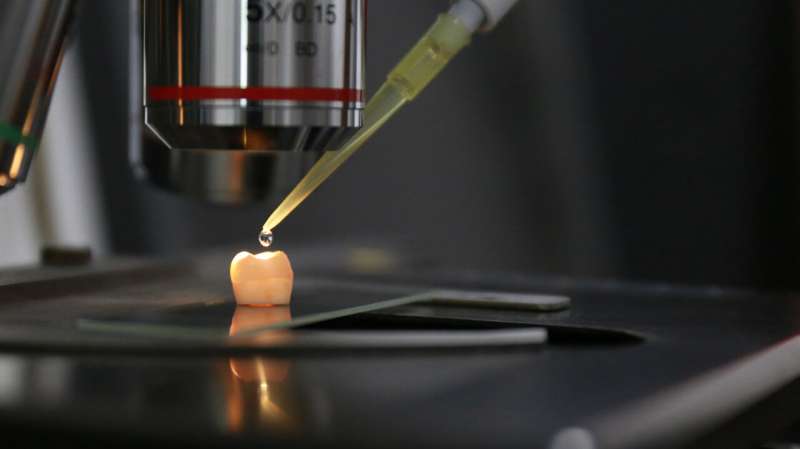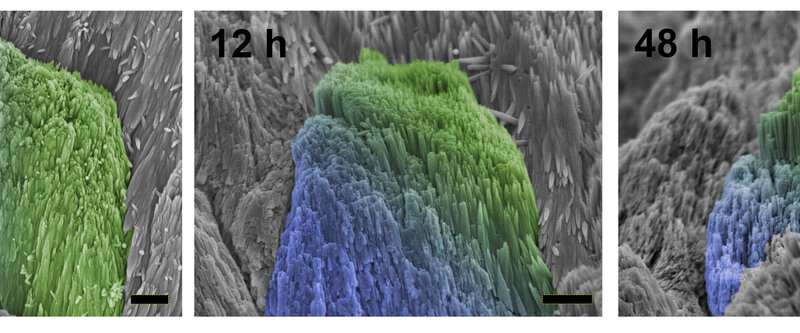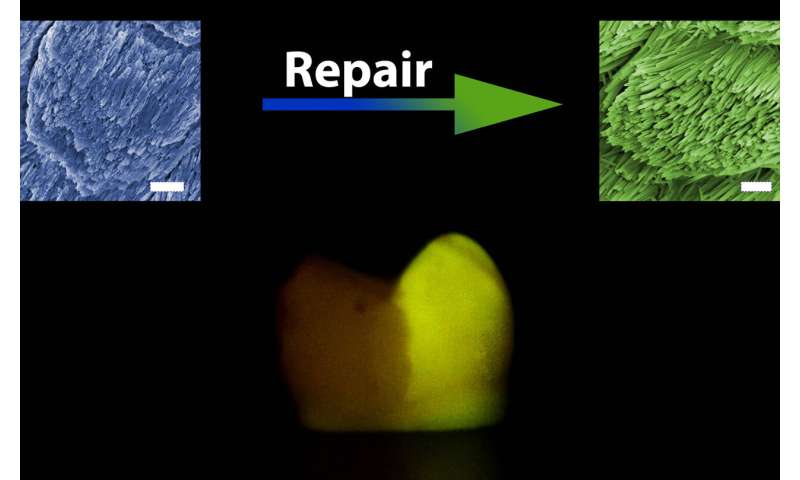September 2, 2019 report
A way to repair tooth enamel

A team of researchers from Zhejiang University and Xiamen University has found a way to repair human tooth enamel. In their paper published in the journal Science Advances, the group describes their process and how well it worked when tested.
Humans have battled tooth decay for thousands of years—the longer we live, the more challenging the problem becomes. Many consumables lead to loss of the hard enamel that protects teeth from decay—and once lost, it never grows back. The current standard treatment involves removal of rotted tooth material and filling the cavity with a hard replacement material. For many years, scientists have sought a way to replace tooth enamel once it is lost—but until now, such efforts have not led to a suitable replacement. In this new effort, the researchers in China report that they have at long last found a solution.
To repair tooth enamel, the researchers first created extremely tiny (1.5-nanometer diameter) clusters of calcium phosphate, the main ingredient of natural enamel. Each of the tiny clusters was then prepared with the chemical compound triethylamine—doing so prevented the clusters from clumping together. The clusters were then mixed with a gel that was applied to a sample of crystalline hydroxyapatite—a material very similar to human enamel. Testing showed that the clusters fused with the tooth stand-in, and in doing so, created a layer that covered the sample. They further report that the layer was much more tightly arranged than prior teams had achieved with similar work. They claim that such tightness allowed the new material to fuse with the old as a single layer, rather than multiple crystalline areas.
-

Scanning electron microscope images of human tooth enamel after repairing for 6 hours, 12 hours and 48 hours. The blue area is the native enamel, and the green area is the repaired enamel. The black scale bars are 1 μm. Credit: Zhejiang University -

Snapshot of an individual human tooth. The left part is the non-repaired area (displayed as dark) and the right part is the repaired area by our material (displayed as yellow, the color is induced by a fluorescent chemical label so as to have a better contrast). Both insets are scanning electron microscope images of enamel. The white scale bars are 1 μm. Credit: Zhejiang University
The team then carried out the same type of testing using real human teeth that had been treated with acid to remove the enamel. They report that within 48 hours of application, crystalline layers of approximately 2.7 micrometers had formed on the teeth. Close examination with a microscope showed that the layer had a fish-scale like structure very similar to that of natural enamel. Physical testing showed the enamel to be nearly identical to natural enamel in strength and wear resistance.
The researchers note that more work is required before their technique can be used by dentists—primarily to make sure that it does not have any undesirable side effects.
More information: Changyu Shao et al. Repair of tooth enamel by a biomimetic mineralization frontier ensuring epitaxial growth, Science Advances (2019). DOI: 10.1126/sciadv.aaw9569
Journal information: Science Advances
© 2019 Science X Network





















